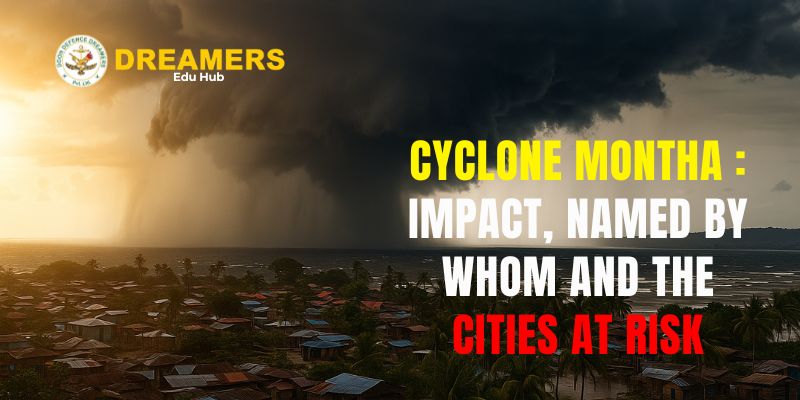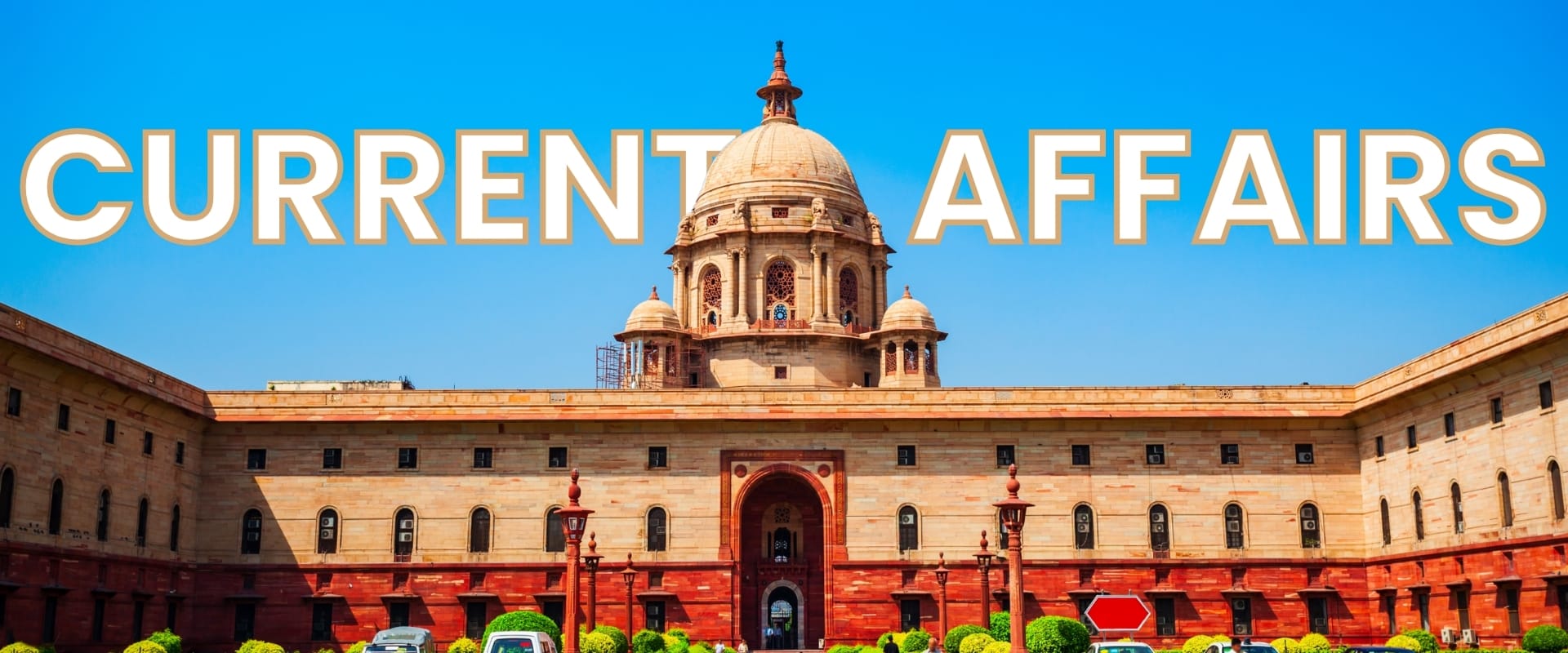India is facing a dual marine threat: a strengthening cyclonic system over the southeast Bay of Bengal (now named Cyclone Montha) and rough weather over the east-central Arabian Sea. The India Meteorological Department (IMD) warns that Montha will intensify into a Severe Cyclonic Storm by the morning of 28 October and move toward the Andhra Pradesh coast, with landfall expected on the evening/night of Tuesday, 28 October. Authorities have placed disaster response teams and the Indian Army on standby, and several coastal districts are on red alert.
Quick facts (Cyclone Montha)
Name & origin: Montha was contributed by Thailand in the WMO/ESCAP naming list for North Indian Ocean cyclones. The word means a fragrant/beautiful flower, and names are assigned once sustained winds reach 34 knots (≈62 km/h). IMD, as the Regional Specialized Meteorological Centre, announces the name.
Current status (Oct 27): Montha has intensified into a cyclonic storm over the Bay and is moving NW → NNW, with further strengthening predicted into a Severe Cyclonic Storm by Oct 28 morning.
Expected landfall window: Evening/night, Oct 28 (Tue), along the Andhra Pradesh coast—most consistently indicated between Machilipatnam and Kakinada (near Kakinada). Peak 3-sec gusts could touch ~100–110 km/h around landfall.
Twin-basin risk: While the Bay system drives the primary threat, the east-central Arabian Sea remains rough to very rough (small craft and fishermen warned off-sea).
Who named “Montha” and why naming matters
Cyclone names for our region are drawn from a list provided by 13 countries under the WMO/ESCAP Panel on Tropical Cyclones; IMD assigns the next name once a system reaches tropical-storm strength. “Montha” was proposed by Thailand, pronounced “Mon-Tha,” and helps ensure clear, fast public communication during emergencies.
Track & intensity: What IMD guidance and models say
IMD’s morning bulletin indicates Montha lay over the SW & adjoining West-central/Southeast Bay (near 12.2°N, 85.3°E at 5:30 AM), moving ~15 km/h and set to intensify to Severe Cyclonic Storm by Oct 28 (AM).
Multiple updates converge on landfall along coastal Andhra Pradesh between Machilipatnam and Kakinada—with Kakinada frequently mentioned as the nearest reference point—on Oct 28 evening/night.
Wind & sea: IMD warns of gale winds over the west-central/northwest Bay ramping up to 90–100 km/h from Oct 28 morning, very high sea conditions near the core, and ~1 m storm surge potential over low-lying coastal Andhra & Yanam at landfall. Fishermen are advised not to venture into the Bay and to return to coast immediately.
Cities & districts likely to be most affected
Highest-risk coastal Andhra stretch (landfall corridor)
Kakinada, Amalapuram/Konaseema, Yanam (Puducherry enclave), East & West Godavari, Machilipatnam (Krishna), Bapatla, Guntur, Eluru, Anakapalle, Visakhapatnam (coast), Kakinada–Machilipatnam belt overall. Expect damaging winds (90–100 km/h, gusts ~110) near the core, very heavy to extremely heavy rain, power disruptions, tree falls, and localized flooding.
Northern AP to south Odisha (peripheral to significant impact)
Visakhapatnam city & suburbs, Vizianagaram, Srikakulam (AP north coast) and Ganjam, Gajapati, Rayagada, Malkangiri, Koraput (South Odisha): squally winds, very heavy rain at times, localized urban waterlogging, and brief transport disruption possible from Oct 28–29 as bands wrap around the system.
Chennai & north Tamil Nadu (outer bands)
Chennai, Tiruvallur, Kancheepuram/Chengalpattu may see spells of heavy rain, waterlogging & gusty winds tied to Montha’s outer cloud bands and an active NE monsoon phase. Orange alerts have been noted locally.
West Bengal (indirect effects)
Kolkata, South/North 24 Parganas, Howrah, Hooghly, East/West Midnapore can get light-to-moderate rain, thundershowers, 30–40 km/h gusts as distant outer bands brush the region—indirect impact only.
Arabian Sea side (marine hazard focus)
Kerala, coastal Karnataka, Lakshadweep/Comorin area: rough to very rough sea; squally conditions up to 40–55 km/h (gusts 60–65); strict no-fishing advisories through 27 Oct, improving thereafter.
Government & response readiness
Army/NDRF/State disaster forces are on high alert with pre-positioned teams, school closures in several AP districts, and coastal evacuation plans for vulnerable pockets. Control rooms are active for rapid clearance of fallen trees, power faults, and emergent rescue.
What risks should people prepare for?
Wind damage: Tin/thatched roofs, signboards/hoardings, weak trees/poles are vulnerable especially near the landfall arc (Machilipatnam–Kakinada).
Flooding & waterlogging: Urban low-lying zones, underpasses, and poor-drainage stretches are prone to short-duration flash flooding during intense bands.
Storm surge: ~1 metre above astronomical tide could inundate very low-lying pockets of coastal AP & Yanam around landfall time.
Transport disruptions: Temporary halts or delays in flights, rail, and buses—check status before travel. Fisheries & port operations may be curtailed.
Practical checklist (save & share)
Heed official warnings: Follow IMD district warnings and your district admin updates.
Stay off the sea & seawalls: No fishing or coastal sightseeing; rogue waves and gusts are deadly.
Secure loose items: Pots, signage, light roofs; tape/board windows if exposed.
Power & comms: Keep devices charged; have torches, spare batteries, and a charged power bank.
Water & meds: 2–3 days’ drinking water, essential medicines, and a small dry-food kit.
Documents: Store ID/insurance/bank papers in waterproof pouches.
If told to evacuate—go early: Know your route to the nearest relief shelter.
Bottom line
Most at risk: Kakinada–Machilipatnam corridor and adjacent AP coastal districts on Oct 28 evening/night.
Also watch: Visakhapatnam belt, South Odisha districts, Chennai & N TN (rain/winds), and marine hazards along Kerala–Karnataka–Lakshadweep.
Name & origin: “Montha”—named by Thailand; means fragrant/beautiful flower.
Sources & verification
IMD National/Marine warnings & press release (Oct 26–27): storm winds 90–100 km/h over Bay segments, ~1 m storm surge risk for coastal AP & Yanam; district-wise risk lists for AP & South Odisha; Arabian Sea rough/very rough.
New Indian Express (Oct 27): Montha intensified; position, distances; Severe Cyclonic Storm by Oct 28 AM; track NW → NNW.
Times of India (Oct 26–27): Landfall near Kakinada; corridor Machilipatnam–Kalingapatnam; state advisories.
AP local updates (school closures/readiness): districts like Visakhapatnam, Anakapalle, West Godavari on watch.
Naming explainer: Thailand contributed “Montha”; meaning & naming rules; IMD as RSMC for the region.





























